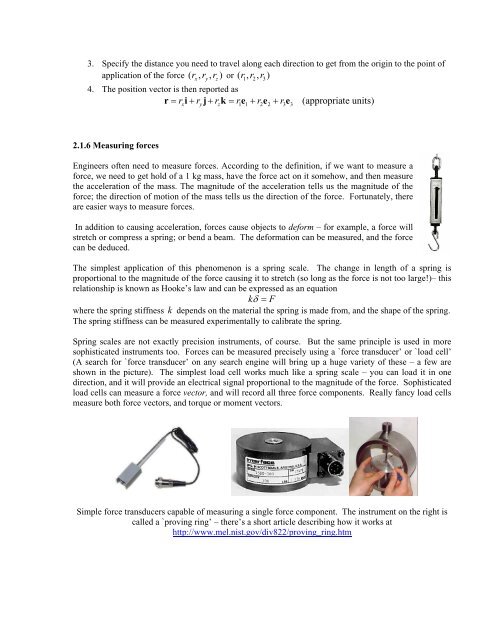Chapter 2 Review of Forces and Moments - Brown University
Chapter 2 Review of Forces and Moments - Brown University
Chapter 2 Review of Forces and Moments - Brown University
Create successful ePaper yourself
Turn your PDF publications into a flip-book with our unique Google optimized e-Paper software.
3. Specify the distance you need to travel along each direction to get from the origin to the point <strong>of</strong><br />
application <strong>of</strong> the force ( rx , ry, r<br />
z)<br />
or ( r1, r2, r<br />
3)<br />
4. The position vector is then reported as<br />
r = rxi+ ryj+ rzk = r1e1+ r2e2+<br />
r3e<br />
3<br />
(appropriate units)<br />
2.1.6 Measuring forces<br />
Engineers <strong>of</strong>ten need to measure forces. According to the definition, if we want to measure a<br />
force, we need to get hold <strong>of</strong> a 1 kg mass, have the force act on it somehow, <strong>and</strong> then measure<br />
the acceleration <strong>of</strong> the mass. The magnitude <strong>of</strong> the acceleration tells us the magnitude <strong>of</strong> the<br />
force; the direction <strong>of</strong> motion <strong>of</strong> the mass tells us the direction <strong>of</strong> the force. Fortunately, there<br />
are easier ways to measure forces.<br />
In addition to causing acceleration, forces cause objects to deform – for example, a force will<br />
stretch or compress a spring; or bend a beam. The deformation can be measured, <strong>and</strong> the force<br />
can be deduced.<br />
The simplest application <strong>of</strong> this phenomenon is a spring scale. The change in length <strong>of</strong> a spring is<br />
proportional to the magnitude <strong>of</strong> the force causing it to stretch (so long as the force is not too large!)– this<br />
relationship is known as Hooke’s law <strong>and</strong> can be expressed as an equation<br />
kδ = F<br />
where the spring stiffness k depends on the material the spring is made from, <strong>and</strong> the shape <strong>of</strong> the spring.<br />
The spring stiffness can be measured experimentally to calibrate the spring.<br />
Spring scales are not exactly precision instruments, <strong>of</strong> course. But the same principle is used in more<br />
sophisticated instruments too. <strong>Forces</strong> can be measured precisely using a `force transducer’ or `load cell’<br />
(A search for `force transducer’ on any search engine will bring up a huge variety <strong>of</strong> these – a few are<br />
shown in the picture). The simplest load cell works much like a spring scale – you can load it in one<br />
direction, <strong>and</strong> it will provide an electrical signal proportional to the magnitude <strong>of</strong> the force. Sophisticated<br />
load cells can measure a force vector, <strong>and</strong> will record all three force components. Really fancy load cells<br />
measure both force vectors, <strong>and</strong> torque or moment vectors.<br />
Simple force transducers capable <strong>of</strong> measuring a single force component. The instrument on the right is<br />
called a `proving ring’ – there’s a short article describing how it works at<br />
http://www.mel.nist.gov/div822/proving_ring.htm
















